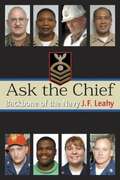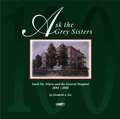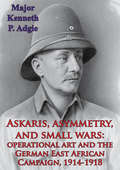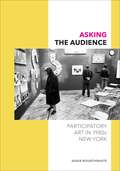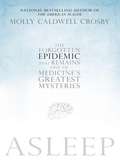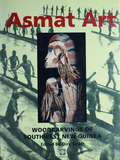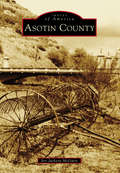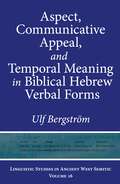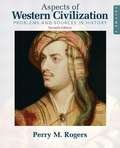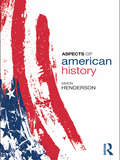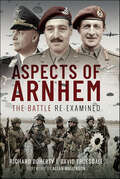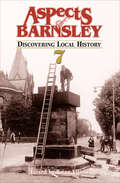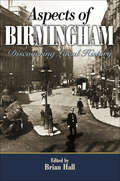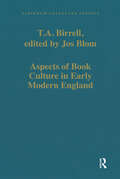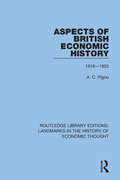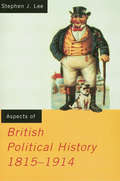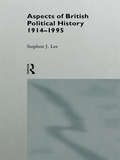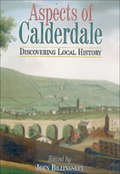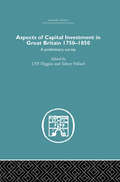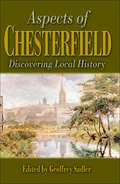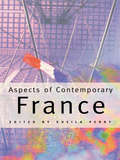- Table View
- List View
Ask the Chief: Backbone of the Navy
by J. F. LeahyAs a guest of the chief petty officers mess aboard USS George Washington during Operation Enduring Freedom, Leahy was granted complete and unfettered access to all areas of the massive carrier as well as the other ships in her battle group.
Ask the Grey Sisters: Sault Ste. Marie and the General Hospital, 1898-1998
by Elizabeth A. IlesAsk the Grey Sisters: Sault Ste. Marie and the General Hospital, 1898-1998 tells the story of the creation and one-hundred-year history of the Sault Ste. Marie General Hospital. At a time when Canada’s healthcare system is at a crossroads and we are asked to make crucial decisions for its future, it is intriguing and enlightening to look at the colourful past of a typical community hospital. Throughout the 1890s, Sault Ste. Marie was a town in search of a hospital. Its glory days at the centre of the fur-trade route were long gone and the Sault was in the process of becoming a modern industrial community. Such a community needed a hospital as a centrepiece to attract investors and as a necessary social institution to care for the hundreds of workers who were flocking to town without family support. The General Hospital was established in 1898 after the town committee charged with developing a hospital had been refused funding by both the federal and provincial governments. In desperation, the committee met with the provincial Inspector of Asylums and Prisons (the only provincial official with hospitals in his mandate). "If you wish a hospital of which the work is serious and lasting," he is reported to have advised them, "ask the Grey Sisters." And so began a fruitful association between the community of Sault Ste. Marie and two orders of Grey Sisters who have operated the hospital through its one-hundred-year history. Based in part on the extensive archival collections of both orders of nuns, this history includes material from the sisters’ Chronicles and their personal reminiscences. The result is an intimate and detailed portrait of a community hospital, placed in the context of an emerging provincial system of health care.
Askaris, Asymmetry, And Small Wars: Operational Art And The German East African Campaign, 1914-1918
by Major Kenneth P. AdgieThis monograph analyzed whether Lieutenant Colonel Paul von Lettow-Vorbeck used operational art to defeat British forces in the East African campaign of World War I. British forces were superior in quantity of men and equipment, but slow moving and heavily dependent on secure lines of communication. Lettow-Vorbeck's forces maintained an asymmetric advantage in mobility, knowledge of terrain, and responsive logistics. An analogy was suggested that the U.S. Army in the twenty-first century is similar to British forces in 1914, and the nation's future adversaries could potentially use Lettow-Vorbeck's unconventional warfare and asymmetric tactics woven together in a comprehensive campaign plan.This monograph reviewed the origins and characteristics of operational art. The Army's emerging doctrine, Student Text 3-0, Operations defines operational art as the "use of military force to achieve strategic goals through the design, organization, integration, and conduct of theater strategic, campaigns, major operations, and battles" and serves as the entry point for discussion. A synthesis of Shimon Naveh and James Schneider's theories revealed five primary characteristics of operational art and was used as the criteria to evaluate the research question. The five characteristics were: operational objectives, operational maneuver, disruption, operational approach, and operational logistics. The East African campaign was analyzed from the perspective of Lettow-Vorbeck linking his strategic aim of forcing the British to commit forces to a secondary theater of operations to his limited resources. The four-year campaign was divided into three phases based on Lettow-Vorbeck's operational objectives and the correlation of forces. Significant tactical vignettes were examined as part of an overarching campaign plan. Finally, this monograph considered how the U.S. Army would fight an asymmetric enemy in a similar environment.
Asking for a Friend: Three Centuries of Advice on Life, Love, Money, and Other Burning Questions from a Nation Obsessed
by Jessica WeisbergA delightful history of Americans' obsession with advice--from Poor Richard to Dr. Spock to Miss MannersAmericans, for all our talk of pulling ourselves up by our bootstraps, obsessively seek advice on matters large and small. Perhaps precisely because we believe in bettering ourselves and our circumstances in life, we ask for guidance constantly. And this has been true since our nation's earliest days: from the colonial era on, there have always been people eager to step up and offer advice, some of it lousy, some of it thoughtful, but all of it read and debated by generations of Americans.Jessica Weisberg takes readers on a tour of the advice-givers who have made their names, and sometimes their fortunes, by telling Americans what to do. You probably don't want to follow all the advice they proffered. Eating graham crackers will not make you a better person, and wearing blue to work won't guarantee a promotion. But for all that has changed in American life, it's a comfort to know that our hang-ups, fears, and hopes have not. We've always loved seeking advice--so long as it's anonymous, and as long as it's clear that we're not asking for ourselves; we're just asking for a friend.
Asking the Audience: Participatory Art in 1980s New York
by Adair RounthwaiteThe 1980s was a critical decade in shaping today&’s art production. While newly visible work concerned with power and identity hinted at a shift toward multiculturalism, the &‘80s were also a time of social conservatism that resulted in substantial changes in arts funding. In Asking the Audience, Adair Rounthwaite uses this context to analyze the rising popularity of audience participation in American art during this important decade.Rounthwaite explores two seminal and interrelated art projects sponsored by the Dia Art Foundation in New York: Group Material&’s Democracy and Martha Rosler&’s If You Lived Here…. These projects married issues of social activism—such as homelessness and the AIDS crisis—with various forms of public participation, setting the precedent for the high-profile participatory practices currently dominating global contemporary art. Rounthwaite draws on diverse archival images, audio recordings, and more than thirty new interviews to analyze the live affective dynamics to which the projects gave rise. Seeking to foreground the audience experience in understanding the social context of participatory art, she argues that affect is key to the audience&’s ability to exercise agency within the participatory artwork.From artists and audiences to institutions, funders, and critics, Asking the Audience traces the networks that participatory art creates between various agents, demonstrating how, since the 1980s, leftist political engagement has become a cornerstone of the institutionalized consumption of contemporary art.
Asleep
by Molly Caldwell CrosbyA fascinating look at a bizarre, forgotten epidemic from the national bestselling author of The American Plague. In 1918, a world war raged, and a lethal strain of influenza circled the globe. In the midst of all this death, a bizarre disease appeared in Europe. Eventually known as encephalitis lethargica, or sleeping sickness, it spread worldwide, leaving millions dead or locked in institutions. Then, in 1927, it disappeared as suddenly as it arrived. Asleep, set in 1920s and '30s New York, follows a group of neurologists through hospitals and asylums as they try to solve this epidemic and treat its victims-who learned the worst fate was not dying of it, but surviving it.
Asleep
by Molly Caldwell CrosbyA fascinating look at a bizarre, forgotten epidemic from the national bestselling author of The American Plague. In 1918, a world war raged, and a lethal strain of influenza circled the globe. In the midst of all this death, a bizarre disease appeared in Europe. Eventually known as encephalitis lethargica, or sleeping sickness, it spread worldwide, leaving millions dead or locked in institutions. Then, in 1927, it disappeared as suddenly as it arrived. Asleep, set in 1920s and '30s New York, follows a group of neurologists through hospitals and asylums as they try to solve this epidemic and treat its victims-who learned the worst fate was not dying of it, but surviving it.
Asmat Art
by Dirk SmidtThis book presents a full range of Asmat woodcarving art, but emphasizes the rare early shields and figure sculptures in the collection of the Rijksmuseum voor Volkenkunde, the National Museum of Ethnology in Leiden. Drums, canoeprowheads and the larger, more dramatic "objects" are also shown. * Together with bisj poles, war shields are perhaps the most famous creation of Asmat artists, and these were carved throughout the region. It is in the design and construction of the shields that the variations in style region can most clearly be seen. Figure sculptures, of varying styles, are also well represented here, and a limited number of the huge ceremonial carvings, such as bisj poles and basu suangkus, have also been included. The cultural context in which these items play their part is described in detail in the introductory chapters. But it is not the intention of this book to be an ethnography. The focus is on the art pieces themselves.
Asotin County (Images of America)
by Jeri Jackson McguireAsotin, Anatone, Cloverland, Clarkston, and Silcott are all towns within Asotin County, an area rich in local history. Names like Lewis and Clark, Chief Joseph, Capt. Benjamin Bonneville, Capt. Edward Steptoe, Chief Looking Class, Chief Timothy, and Henry Spaulding all had early ties to the area. Asotin was carved out of Garfield County on October 27, 1883. There are fascinating stories of early pioneers, such as Weissenfels, Floch, Wilson, Stone, Critchfield, Halsey, and many more, who came from far and wide to settle the area, becoming farmers, building towns, and establishing an irrigation system. Through the years, Asotin has encountered floods, murders, hangings, a disastrous fire, and a fight to retain the county seat. At one point, the residents thought they might have to battle the Nez Perce Indians, but they were peaceful and very kind to the people.
Aspect, Communicative Appeal, and Temporal Meaning in Biblical Hebrew Verbal Forms (Linguistic Studies in Ancient West Semitic #16)
by Ulf BergströmThis book provides a new explanation for what has long been a challenge for scholars of Biblical Hebrew: how to understand the expression of verbal tense and aspect.Working from a representative text corpus, combined with database queries of specific usages and surveys of examples discussed in the scholarly literature, Ulf Bergström gives a comprehensive overview of the semantic meanings of the verbal forms, along with a significant sample of the variation of pragmatically inferred tense, aspect, or modality (TAM) meanings. Bergström applies diachronic typology and a redefined concept of aspect to demonstrate that Biblical Hebrew verbal forms have basic aspectual and derived temporal meanings and that communicative appeal, the action-triggering function of language, affects verbal semantics and promotes the diversification of tense meanings. Bergström’s overarching explanation of the semantic development of the Biblical Hebrew verbal system is an important contribution to the study of the evolution of the verbal system and meanings of individual verbs in the Hebrew Bible. Accessibly written and structured for seminar use, Bergström’s study brings new perspectives to a debate that, in many ways, had reached a stalemate, and it challenges scholars working with TAM and the Biblical Hebrew verb to revisit their theoretical premises. Advanced students and scholars of Biblical Hebrew and other Semitic languages will find the study thought provoking, and linguists will appreciate its contributions to linguistic theory and typology.
Aspect, Communicative Appeal, and Temporal Meaning in Biblical Hebrew Verbal Forms (Linguistic Studies in Ancient West Semitic)
by Ulf BergströmThis book provides a new explanation for what has long been a challenge for scholars of Biblical Hebrew: how to understand the expression of verbal tense and aspect.Working from a representative text corpus, combined with database queries of specific usages and surveys of examples discussed in the scholarly literature, Ulf Bergström gives a comprehensive overview of the semantic meanings of the verbal forms, along with a significant sample of the variation of pragmatically inferred tense, aspect, or modality (TAM) meanings. Bergström applies diachronic typology and a redefined concept of aspect to demonstrate that Biblical Hebrew verbal forms have basic aspectual and derived temporal meanings and that communicative appeal, the action-triggering function of language, affects verbal semantics and promotes the diversification of tense meanings. Bergström’s overarching explanation of the semantic development of the Biblical Hebrew verbal system is an important contribution to the study of the evolution of the verbal system and meanings of individual verbs in the Hebrew Bible. Accessibly written and structured for seminar use, Bergström’s study brings new perspectives to a debate that, in many ways, had reached a stalemate, and it challenges scholars working with TAM and the Biblical Hebrew verb to revisit their theoretical premises. Advanced students and scholars of Biblical Hebrew and other Semitic languages will find the study thought provoking, and linguists will appreciate its contributions to linguistic theory and typology.
Aspects Of Western Civilization: Problems And Sources In History, Volume 2
by Perry RogersAspects of Western Civilization : Problems and Sources in History, Volume 1, 7/e, challenges students with basic questions regarding historical development, human nature, moral action, and practical necessity. This collection of diverse primary sources explores a wide variety of issues and is organized around seven major themes: the Power Structure, Social and Spiritual Values, the Institution and the Individual, Imperialism, Revolution and Historical Transition, the Varieties of Truth, and Women in History.
Aspects of American History
by Simon HendersonAspects of American History examines major themes, personalities and issues across American history, using topic focused essays. Each chapter focuses on key events and time periods within a broad framework looking at liberty and equality, the role of government and national identity. The volume engages with its central themes through a broad ranging examination of aspects of the American past, including discussions of political history, foreign policy, presidential leadership and the construction of national memory. In each essay, Simon Henderson: introduces fresh angles to traditional topics consolidates recent research in themed essays analyzes views of different historians offers an interpretive rather than narrative approach gives concise treatment to complex issues. Including an introduction which places key themes in context, this book enables readers to make comparisons and trace major thematic developments across American history.
Aspects of Anglican Identity
by Colin PodmoreTensions within the Anglican Communion and discussions about the possibility of women bishops have thrown a spotlight onto underlying issues such as:How are decisions taken in the Church? What are the roles of synods, bishops and primates? How should the Archbishop of Canterbury's ministry develop? What do being 'in communion' and 'out of communion' mean? How significant are diocesan boundaries in an age of globalization?Behind the headline-provoking debates are questions about the very identity of the Church of England and the Anglican Communion. How do Anglicans understand their own church and its place within the wider Church? In this lucid and accessible collection of essays, Colin Podmore draws on his expertise and experience, and explores these and related topics, setting them in their historical context. He also explains how synodical government works and looks at the Declaration of Assent, a defining statement of the Church of England's identity.
Aspects of Arnhem: The Battle Re-examined
by Richard Doherty David TruesdaleAlmost 80 years on the battle for the Arnhem Rhine crossing remains controversial. Opinion on its justification and success differs widely. This superbly researched book, written by two acknowledged experts, takes a wide-ranging examination of Operation Market Garden from the strategic, operational and tactical level. The role of the Allied commanders involved is scrutinized with surprising results. For example, US General Brereton’s pivotal role has seldom been mentioned, yet he is revealed as responsible for choosing landing and drop zones. The record of airborne forces, both German and Allied, prior to September 1944 raises questions and the doubt that many senior commanders, including Eisenhower, had as to their effectiveness is highlighted. The parts played by VIII and XII Corps of Second Army and General Dempsey, its Commander are scrutinized, as are the actions of local commanders and troops on the ground. Both those with a deep interest in military history and the layman will find much to inform and satisfy them in this valuable and at times provocative account.
Aspects of Barnsley 7: Discovering Local History
by Brian ElliotThe Aspects series takes the readers on a voyage of nostalgic discovery through their town, city or area. Following on from the success of Aspects of Barnsley 6, the series continues with Aspects of Barnsley 7. Brian Elliott offers the reader a chance to become re-acquainted with the forgotten by-ways of the social history in the Barnsley area. Aspects of Barnsley 7 contains a well researched and readable history from a variety of experienced and new authors. The topics include personal accounts of local businesses such as Needham Brothers and Station Taxis; Memories of a Barnsley Childhood by an American Resident; Excerpts from Royston School log Books; Johnny Westons Monk Bretton; New Insight Concerning 2 Worsborough Collieries; Some Characters of Old Darfield; Postcards from Barnsley; and The Ancient Place-Names of the Barnsley Metropolitan Borough. All of these are captivated with fantastic illustrations, in Aspects of Barnsley 7.
Aspects of Birmingham: Discovering Local History (Aspects Of Ser.)
by Brian HallThere are now over 25 books published as part of the Aspects Series, each one taking readers on a voyage of nostalgic discovery through their town, city or area. Here Birmingham, once "The Workshop of the Empire" is revealed in twelve studies of the city and its people. Here we find "Birmingham Municipal Bank", the only successful council operated bank and "Lesser Known Characters" about the city. We see the work of the "Birmingham Mission" and "Birmingham Children's Emigration Homes". During the troubled 1930's, Birmingham held a "Great Pageant" and as war clouds gathered over Europe, the city's young men fought in "The Spanish Civil War". All this and so much more is available in this, the first Aspects of Birmingham.
Aspects of Book Culture in Early Modern England (Variorum Collected Studies)
by T.A. Birrell edited by BlomThomas Anthony Birrell (1924-2011) was a man of many parts. For most of his working life he was Professor of English Literature in the University of Nijmegen, The Netherlands, where he was famous for his lively, humoristic and thought-provoking lectures. He was the author of some very popular literary surveys in Dutch, one of which - a history of English literature - has had seven editions so far. However, first and foremost he was a bibliographer and a book historian. The present collection contains fifteen of his book-historical articles, two reviews and one published version of a lecture for the illustrious ’Association Internationale de Bibliophilie’. The lecture - with a wealth of illustrations - about the British Library as the ’Custodian of the Unique’ gives one a sense of Birrell’s ability to present an audience with a complicated topic in comprehensible, but not simplified, terms. The reviews serve as a statement of principle of how to tackle the subject of ’English readers and books’ and the standards that ought to apply. The articles demonstrate Tom Birrell’s in-depth knowledge, dedication and scholarship. He once said that he felt that he could have talked to the 17th-century London booksellers on an equal footing and his work convinces one that they would have enjoyed these conversations. Aspects of Book Culture was edited by Birrell’s former pupil, colleague, friend and fellow-bibliographer Jos Blom.
Aspects of British Economic History: 1918-1925 (Routledge Library Editions: Landmarks in the History of Economic Thought #6)
by A. C. PigouCovering the period from November 1918 to the restoration of the Gold Standard in the UK in April 1925, this book, originally published in 1947, sets out and explains the economic facts of the immediate post-war period. There are sections on employment, production, government intervention in industry, the monetary factor, real income and real wages. A statistical appendix brings together in four sections a number of important tables which supplement the text.
Aspects of British Political History 1815-1914
by Stephen J. LeeAspects of British History, 1815-1914 addresses the major issues of this much-studied period in a clear and digestible form.* Introduces a fresh feel to long-studied topics* Consolidates a grest deal of recent research* Carefully organised to reflect the way teachers tackle this course* Written by and experienced and renowned textbook author* Illustrated with helpful maps and photographs
Aspects of British Political History 1914-1995
by Stephen J. LeeAspects of British Political History 1914-1995 examines all the major themes, personalities and issues of this important period in a clear and digestible form. It:* introduces fresh angles to long-studied topics* consolidates a great body of recent research* analyses views of different historians* offers an interpretive rather than narrative approach * gives concise treatment to complex issues* is directly relevant to student questions and courses* is carefully organised to reflect the way teachers tackle these courses* is illustrated with helpful maps, charts, illustrations and photographs.
Aspects of Calderdale: Discovering Local History
by John BillingsleyThe Aspects series takes readers on a voyage of nostalgic discovery through their town, city or area. This best selling series has now arrived, for the first time, in Calderdale. John Billingsley has gathered a range of articles covering the whole history of the Pennine borough from pre-history to the present day.We start the journey through Calderdale with The Early Prehistory of Calderdale. Then we are exposed to the transition of modern technology and the impact it has, in From Quill to Computer: Public Libraries in Halifax. Calderdale can also have a claim to some well know authors in John Hartley: 'The Yorkshire Burns' and 'Archaeology of the Mouth' Ted Hughes and his birthplace. All these and much more help to shape Calderdale's distinctive and vibrant identity, in Aspects of Calderdale.
Aspects of Capital Investment in Great Britain 1750-1850: A preliminary survey, report of a conference held the University of Sheffield, 5-7 January 1969
by Sidney Pollard J. P. P. HigginsThese six papers were originally delivered to a conference at Sheffield University in 1969 and represent an overview of a research project led by Professor Pollard, which aimed to construct a series of annual figures of capital formation for the Industrial Revolution in Britain - both in aggregate and broken down into main sectors. Each paper is accompanied by a summary of the discussion which followed. The problems encountered in such an undertaking are examined, a major one being definition: what to include in the term 'capital', how to measure or isolate expenditure under that heading, and how to deal with changes which have made the definitions and practices of present-day national income estimates inapplicable to earlier centuries. Sources are also examined in depth as statistical information is not only uncertain and often unreliable, but of different value and completeness for different sectors of the economy. This book was first published in 1971.
Aspects of Chesterfield: Discovering Local History
by Geoffrey SadlerThe Aspects series takes the reader on a voyage of nostalgic discovery through their town, city or area. This best selling series has now arrived, for the first time, in Chesterfield. Geoffrey Sadler offers the reader a chance to become re-acquainted with the forgotten by-ways of the social history in the Chesterfield area.Aspects of Chesterfield contains an interesting group of contributors who explore aspects of the history of the town and its outlying area. Each 'Aspect' is a fine blend of detailed research with personal reminiscence. The various subjects included are; The Rise and Fall of Chesterfield's Rendezvous Dance Hall, Brampton Childhood Memories, Ghosts of Chesterfield, Spital Through the Ages, Chesterfield: An Unexpected Theatre Town and Celebrated Confections and Monster Cakes. All these and much more have been captivated with fascinating illustrations in Aspects of Chesterfield.
Aspects of Contemporary France
by Sheila PerryFrance is defined by claims of uniqueness made by or about the French. Aspects of Contemporary France illuminates the contemporary economic, cultural, political and social climate of France. Using a multidisciplinary approach, this book explains the historical background to controversial issues. It also traces France's road to nationhood through religion, language and territory.Each chapter is by a specialist in the field and is based on the most up to date information and research. Beginning with the present day, the book traces the historical background to events and provides a context for evaluation. The wide-ranging and varied themes covered include:* political parties* regions in the market place* television and film* women* secularism and Islam* linguistic policies* French consumersThe book also offers a helpful chronology at the end of each chapter, a detailed bibliography and a recommended reading list.Aspects of Contemporary France presents an analytical as well as informative appraoch to French Studies. It provides a readily accessible but in-depth understanding for students of France or French civilization at undergraduate and postgraduate levels.
